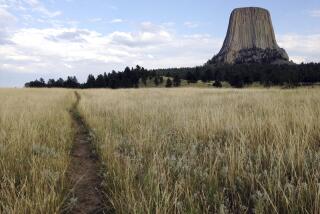Cattle Theft Widespread : Rustlers Raid Range With Trucks
The rustlers drove the back roads, looking for the right spot on John Gill’s place. They didn’t want any surprises as they went about their thieving ways.
In the late afternoon, they began rounding up the cattle on horseback. Or, perhaps, they used herding dogs--no one is sure which. By dusk, they had driven 81 Hereford-Angus steers into a corral and loaded them onto two trucks.
And then they were gone.
Jack Gill, who was not insured, was out $53,000. That means he won’t get a new pickup this year and he won’t be able to repair the barn on his 10,300-acre Rancho Grande, here in the foothills of the High Sierra.
Beef Prices Up
“This should have been my most profitable year in 10 years,” said Gill, 68, whose family has been ranching for three generations. “Beef prices are way up over last year. You don’t get the brass ring that often; you catch it when you can.”
Gill won’t be catching the brass ring this year and neither will thousands of other victims of cattle thieves. Rustlers, part of the American scene since the days of the great trail rides, remain the bane of ranchers from California to Florida.
In California alone, the number of cattle stolen through the first five months of this year stands at 1,222--more than double the number for the same period last year. In Texas, the country’s top cattle-producing state, $4.5-million worth of livestock and equipment was stolen last year.
Virtually every state west of the Mississippi, as well as most in the South, have investigators who specialize in cattle thefts.
They are needed. The cattle thief, using interstate highways for his getaway, is more mobile than ever. No longer can investigators count on finding stolen steers at the auction barn in the next county.
Can Move Cattle Quickly
“The thing people don’t realize is that cattle can be moved from Florida to anywhere in the country in a couple of days,” said John O’Brien, the head of the law enforcement unit for the Florida Department of Agriculture. “Once the cattle are out of our jurisdiction, it’s hard to get them back.”
Hence the assessment of Sacramento County Sheriff’s Deputy Brian Kennedy, who is investigating Gill’s case: “They’re probably hamburgers on the table by now.”
In American lore, the cattle rustler is an archetypal villain, the man with the black hat who would swing from the nearest tree if the good guys should happen upon him in the middle of his work.
The word “rustler,” which referred to cowboys who “rushed and hustled” cows off the open range, was first used in print in 1882 in a publication called Blackwood Magazine: “a gang of ‘rustlers’--as the lawless desperadoes who abound in Texas, New Mexico and Arizona are called.”
But the picture of the modern rustler is somewhat different from the stereotype. Today’s rustlers steal most often from someone they know and usually limit themselves to one or two animals. And, although many cattle thieves are hard-core criminals, others are stealing because times are tough and they are behind on house or credit card payments.
“When the economy gets bad, you get more people stealing them to eat,” said Gary Shoun, Colorado’s brand inspector. “When the market is good, you get more people stealing the stock to resell.”
Another variety of cattle theft involves ranchers who steal from themselves to collect insurance. That has happened with more regularity as farm and ranch economies have fallen, causing insurance companies--alarmed by the increasing number of claims--to stop paying on mysterious disappearances.
Danger Is Minimal
Stealing cattle is certainly more profitable than stealing television sets; unbranded cattle can be sold at full price in auction barns. And, on the vast ranches in the West, the danger of being caught is certainly less than in burglarizing a home.
“It’s impossible for the ranchers to watch their cattle day and night out on the range,” said Del Pedro, the director of California’s Bureau of Livestock Identification. “It’s a pretty good risk for the modern-day cattle rustler pulling in with a big rig, loading the animals in quick time. It’s better than robbing a bank. Sometimes ranchers don’t realize they have been hit until weeks later, when they gather their animals to take them to market.”
However, stealing cattle is not something that a second-story artist, say, might want to try for a change of pace.
“There’re a lot of ways to steal cattle, but there’re only a few people who know enough to do it,” Florida official O’Brien said. “You have to be around cattle and know how to handle them. You have to know how to feed them and how much stress they can stand on a livestock truck. You can’t learn that from watching a John Wayne movie.”
Rancher Loses 65 Head
Cattle rustling ranges from sophisticated operations to something much less than that. Certainly, rustlers did know what they were doing when they hit Jack Sparrowk’s ranch in California’s San Joaquin County. So far this year, Sparrowk has lost 65 head of cattle worth $40,000.
“That included six of my wife’s 60 purebred Beefmaster cattle in a pasture across from our home,” he said. “They stole them right out from under our eyes.”
A counterpoint to that is the story told by Bobby Pruitt, an Alabama cattle theft investigator who pulled over a car one stormy night about six months ago.
“I opened the trunk of that car and it was wall to wall with a 400-pound calf staring back at me,” Pruitt said.
Tennessee investigator Max Thomas tells of tracking an inept thief who shot a calf and, with the help of a friend, dragged the carcass to his nearby home. The young rustler confessed quickly enough and told where the butchered meat could be found. But, as he was sitting in jail, he suddenly remembered something.
“He said, ‘Fellas, I gotta go home. My parents are coming home tomorrow and I left that cowhide in the clothes dryer. It’s gonna be stinkin’ and my mama’s gonna kill me.’ ”
Investigator Slain
Thomas has more sobering stories to tell about cattle rustling, however. Just last month, he said, an undercover investigator and a cattle buyer were shot to death when they were attempting to buy stolen cattle. Thomas, who also was working the case, was on his way to meet the two when they were killed. A pair of brothers have been charged in the killing, he said.
Although rustling pervades most regions of the country, it is impossible to tabulate how many head of cattle are stolen every year. No cattle raisers’ or livestock investigators’ association keeps statistics for all 50 states. Cattle rustling is categorized under a number of headings, from grand larceny to trespassing, depending on where the theft occurred. And, often, cattle owners don’t bother to report the theft because they know that finding the rustler is a lost cause, O’Brien, the Florida investigator, said.
Branding Not Required
Oddly, the major deterrent to cattle rustling--branding--is mandatory only in New Mexico. Many states have brand inspectors, who examine animals at auction barns as they are being sold. But most states in the Midwest and East, two major markets for stolen cattle, do not even have those.
The investigation of rustling is also spotty. Texas, with 32 lawmen who deal only in cattle theft, is far and away the leader in the number of people who work such cases. From there, the numbers drop dramatically. California, for instance, has only one state inspector, and most investigations are done by local sheriff’s departments. But Pedro, of the Bureau of Livestock Identification, said most law enforcement agencies do not make tracking down cattle a major priority.
“In many counties, ranchers are required to mail in a report,” Pedro said. Nobody even comes out to talk to them. Not that much attention is focused on the problem by law enforcement agencies. That’s the trouble.”
Lawmen Lack Technology
That sentiment is widespread. And O’Brien said pursuit of rustlers and other agricultural criminals has been hampered by a lack of technology and shared information. The sophisticated crime-solving methods of the city and the use of computers have been slow in arriving in the country, he said, but that is changing.
Perhaps the nature of cattle rustling is changing as well. Investigators are seeing a rustler who increasingly uses a bad check instead of a trailer to steal cattle. In Florida, investigators are looking for a man who is buying cattle with bad checks and selling them the same day at auction barns close by.
“There’s quite a bit of that going on,” said O’Brien. And Shoun, the Colorado brand inspector, said the same is true in his state: “There are more of the con game kind of people who are swindling people out of their cattle.”
To counter the increase of rustling in California, state officials plan to increase livestock inspection fees and use the funds for an investigation unit devoted solely to cattle theft cases, Pedro said.
Tougher Sentences Sought
Assemblyman Norman Waters (D-Plymouth), chairman of the Assembly’s Agricultural Committee, has introduced legislation to increase the term of imprisonment for cattle theft to a year from six months. That is still lenient by some other states’ standards. Tennessee, for instance, mandates a 5- to 15-year sentence.
Meanwhile, the rustling goes on. One hundred head of cattle were stolen last month from Art Martella’s Crosscreek Ranch in Kings County.
“I can’t just sit here and cry about it.” he said. “All of us have to try to keep a closer check on our cattle counts and hope the law enforcement people will bear down a little more and put the squeeze on the scum out there having a field day now that beef prices are way up.”
More to Read
Sign up for Essential California
The most important California stories and recommendations in your inbox every morning.
You may occasionally receive promotional content from the Los Angeles Times.










